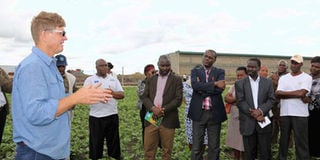To harvest in plenty, I don’t plough my farm

Stuart Barden discusses a point on conservation agriculture with enthusiasts in his farm in Machakos. In the strategy, he uses a combination of three methods, namely zero tillage, permanent soil cover and crop rotation. PHOTO | BONIFACE MWANGI | NMG
What you need to know:
- In zero tillage, soil is minimally disturbed and this makes it retain moisture longer.
- A farmer preparing his land for the first time is supposed to clear the bushes and for the shorter weeds, he sprays them with herbicides.
- Barden harvests 1,000kg of green grams from an acre, with the crop taking 150-160 days to reach maturity.
- Barden has been growing his crops for local market noting that the country has a big deficit of pulses.
A strong wind blows making the trees around the compound in Machakos bend as a section of a roof of the garage clatters.
The winds are a clear indication that heavy rains would pound Small World village in the county, where Stuart Barden, an Australian has lived for six years and is practising conservation farming.
Barden is busy scooping soil from his farm carpeted with green gram crop just as he checks the soil moisture level.
The Australian, who is in his 40s, has for the last two years, been growing chick peas and green grams on 2,000 acres in a rotational manner using unconventional methods that are paying handsomely.
The farm is located in the semi-arid part of Machakos County, but it is lush green and the soils full of moisture as those in the highlands.
“When I came here, my mind was set that I will grow crops using conservation agriculture methods because the area receives little rainfall but has fertile soils,” he says.
The semi-arid region receives less than 600mm of rainfall a year, according to the Meteorological Department.
In conservation farming, he uses a combination of three methods, namely zero tillage, permanent soil cover and crop rotation.
Zero tillage, where the soil is minimally disturbed, makes it retain moisture for a longer period and incase the rains fail, crops are able to reach maturity with the little moisture left in the soils.
A farmer preparing his land for the first time is supposed to clear the bushes and for the shorter weeds, he sprays them with herbicides, explains Barden.
Thereafter, one digs the holes for planting seeds or first tills the land using chisel ploughing to a depth of 20cm before he makes planting holes.
“After this, one is ready to sow seeds or seedlings. The dead weeds are also not burnt or removed from the farm but are let to rot there. This helps in conservation of water as well as enriching soil. They act as mulch,” he says, adding he plants twice a year at the onset of rains.
Before he turned to conservation farming, he says he had tried the normal cultivation back at home and experienced eight crop failure out of the 10 times that he tried.
“If I had not taken this idea, I would be broke by now and perhaps back to my homeland,” he states.
Barden harvests 1,000kg of green grams from an acre, with the crop taking 150-160 days to reach maturity.
BOOST FOOD SECURITY
As for chick peas, he harvests 1,100kg from the same piece of land after 140 days.
“Maturity of any crop depends on climate. If its cold, they take long, but mature faster when hot,” he says.
For the two years Barden has been growing chick peas and green grams, he says he has broken even.
David Njogu, the chief engineer and head of mechanisation in the Ministry of Agriculture, says nearly all crops can be grown using this method.
“Through the same management under similar weather conditions and same size of land, crop grown under conservation agriculture produces 20 per cent more than convention agriculture.”
“This method though is not new, but has more advantages than conventional farming. It lowers the cost of production by 45 per cent since it requires less labour and less machinery usage,” he adds.
He notes conservation agriculture can also be used in regions that receive high rainfall with farmers taking advantage of this to plant twice.
Currently, only less than one per cent of farmers in the country practice conservation agriculture and Njogu says the ministry is working to raise the number to 10 percent.
Barden, who caught the attention of the Ministry of Agriculture, says the method of farming requires 10 per cent tree cover around the farm.
His prowess in the farming has landed him a new title – conservation farming ambassador. The government will use him to sensitise other farmers on the importance and advantages of this type of farming that is used to grow tea.
“The land also needs to be flat so that it can retain water. However, this type of farming only allows one to practice mono-culture. Chemicals sprayed to kill weeds only spare one type of crop on the farm. In this case, a farmer only plants one type at a go or engages in crop paddocking.”
Barden has been growing his crops for local market noting that the country has a big deficit of pulses.
He has employed three workers on a permanent basis and hires several casual labourers during planting, spraying of weeds and harvesting.
“With the changing climate, this is one method of farming that we are certain will boost food security in our country as well as change the lives of our small scale farmers. We will do all it take to advocate for it countrywide,” says Dr Andrew Tuimur, Chief Administrative Secretary, in the Agriculture ministry.




